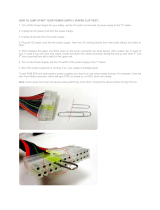
www.pulsar.pl AWZ501
Electrical specifications (tab. 3)
PSU type A (EPS – External Power Source)
Mains supply 230V/AC (-15%/+10%)
Current consumption up to 0,55A
Power frequency 50Hz
PSU power 78W max.
Output voltage 11 V÷13,8Vdc – buffer operation
10 V÷13,8Vdc – battery-assisted operation
Output current 5A+ 0,6A battery charge
4,4A+ 1,2A battery charge
3,8A+ 1,8A battery charge
3,2A+ 2,4A battery charge
Output voltage setting, escalation and keeping time 500ms/150ms/110ms
Voltage adjustment range 11 V÷15 V
Ripple 20mV p-p
Current consumption by PSU systems 77 mA max.
Battery charging current 0,6A/1,2A/1,8A/2,4A jumper selectable J1, J2
Short-circuit protection SCP
Step I = 200% ÷ 250% of PSU power - current limitation and/or fuse
damage in the battery circuit
Step II = 110% ÷ 150% of PSU power – PCT fuse, manual restart
(disconnection of the DC output circuit)
Overload protection OLP
110% ÷ 150% @25ºC÷55ºC of PSU power – current limitation by
the PTC resettable fuse, manual restart (the fault requires
disconnection of the DC output circuit)
Over voltage protection OVP
U>16,5V disconnetion of the output voltage, automatic return
U> 14,5V fault indication
Battery circuit protection SCP and reverse polarity
connection
6,3A - current limitation, T 6,3A fuse (fuse-element replacement
required)
Over-discharge protection UVP
U<10V (± 5%) – disconnection (- BAT) of the battery,
adjustment by the Z3,Z4 jumpers, time lag adjustment:
20s/15min/1h/OFF
Technical outputs:
- AW output indicates PSU fault:
output (SCP, OCP, OVP status);
battery (UVP, SCP status, test: negative, exceeding
the max. temperature
- BS output indicates AC power failure
Protection anti-sabotage:
- TAMPER - indicates enclosure opening or detaching
from the mounting surface
- OC type, 50mA max.
normal status: level L (0V), failure: level hi-Z
- OC type, 50mA max.
normal status: level hi-Z , failure: level L (0V), adjustable time lag:
0s/5min/1h/6h
- 2 micro switches, NC contacts (enclosure closed),
0,5A@50V DC (max.)
LED indication
LEDs: AC/DC power status, failure, control panel: LED display +
keypad
Acoustic indication piezoelectric indicator
F1 fuse T 6,3A
F2 fuse T 3,15 A/ 250V
Mechanical specifications (tab. 4).
Enclosure dimensions 400 x 420 x 172+8 (WxHxD) [mm] (+/- 2)
Fixing 370 x 390, Φ 6x4szt (WxH)
Fitting battery 65Ah/12V (SLA) max.
Net/gross weight 9,5 / 10,0 kg
Enclosure Steel plate DC01, thickness: 1,2mm, colour: RAL 9003
Closing Cheese head screw x2 (at the front), lock assembly possible
Connectors Mains supply 230V: Φ0,63-2,05 (AWG 22-12)
OUT and BS/AW outputs: Φ0,51- 2,05 (AWG 24-12)
Battery outputs: BAT: Φ6 (M6-0-2,5)
TAMPER output: wires
Notes The enclosure does not adjoin the assembly surface so that
cables can be led.
PSU cooling: convectional + fan cooling (automatic)















